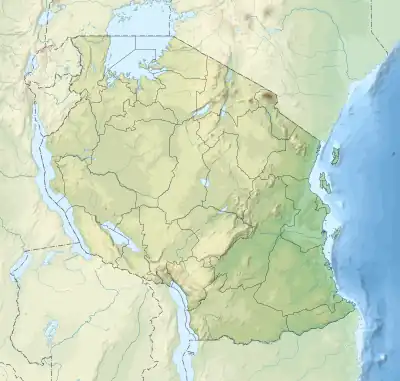 Shown within Tanzania | |
| Location | Uvinza District, Kigoma Region, |
|---|---|
| Coordinates | 4°58′44.04″S 30°17′33.72″E / 4.9789000°S 30.2927000°E |
| Type | Settlement |
| History | |
| Cultures | Vinza |
| Site notes | |
| Condition | Endangered |
| Ownership | Tanzanian Government |
| Management | Antiquities Division, Ministry of Natural Resources and Tourism [1] |
| Official name | Uvinza Salt Works Historic Site |
| Type | Cultural |
Uvinza Salt Works (Eneo la uchimbaji wa chumvi mawe ya Uvinza in Swahili ) are salt mines that have been in used since the Iron Age. There are numerous brine springs in the area. The site is located in the town of Uvinza in Uvinza District of Kigoma Region in Tanzania.[2][3][4][5][6]
References
- ↑ "Antiquities Division". Retrieved 21 Jul 2022.
- ↑ Rockel, Stephen J. (1 January 2000). "Enterprising Partners: Caravan Women in Nineteenth Century Tanzania". Canadian Journal of African Studies. 34 (3): 748–778. doi:10.1080/00083968.2000.10751213. JSTOR 486219. S2CID 143353226.
- ↑ Wynne-Jones, Stephanie (2010). "Lines of Desire: Power and Materiality Along a Tanzanian Caravan Route". Journal of World Prehistory. 23 (4): 219–237. doi:10.1007/s10963-010-9040-4. JSTOR 25801299. S2CID 145570238.
- ↑ Rockel, Stephen J. (2000). "'A Nation of Porters': The Nyamwezi and the Labour Market in Nineteenth-Century Tanzania". The Journal of African History. 41 (2): 173–195. doi:10.1017/S0021853799007628. JSTOR 183432. S2CID 144346261.
- ↑ Oliver, Roland (1982). "The Nilotic Contribution to Bantu Africa". The Journal of African History. 23 (4): 433–442. doi:10.1017/S0021853700021289. JSTOR 182034. S2CID 153539947.
- ↑ Adshead, S. A. M. (27 July 2016). Salt and Civilization. Springer. doi:10.1007/978-1-349-21841-7. ISBN 978-1-349-21841-7.
This article is issued from Wikipedia. The text is licensed under Creative Commons - Attribution - Sharealike. Additional terms may apply for the media files.